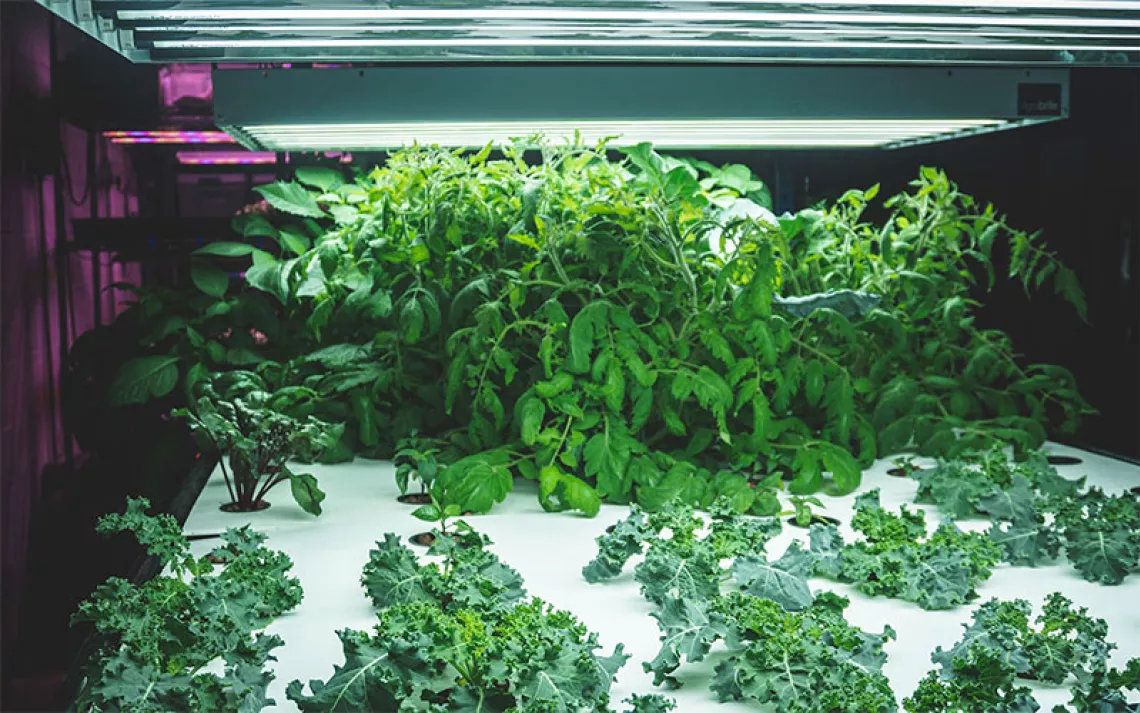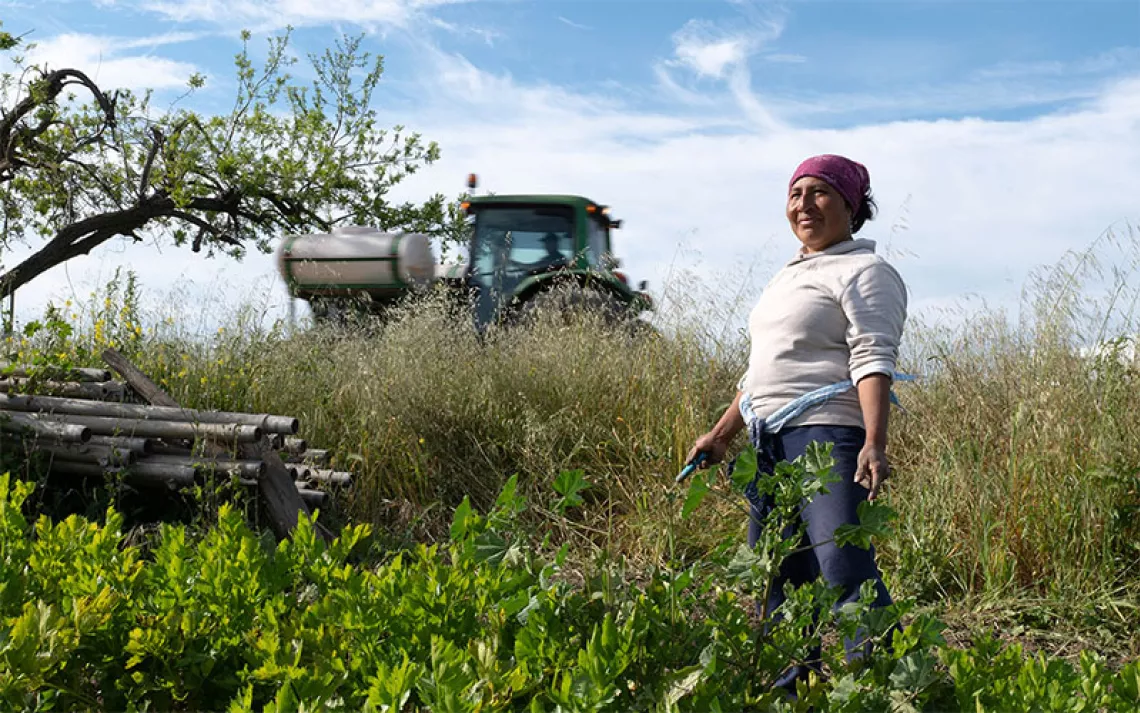5 Ways the Farm Bill Can Help Fix America’s Ag System
Here is what land and climate advocates say can be done to make farming more sustainable and equitable

Photo by iStock/baona
Liz and Brian Bawden have managed an organic dairy in upstate New York for 23 years. They don’t use antibiotics, herbicides, or pesticides, and they nourish their pastures with composted manure and bedding. About a year ago, the Bawdens transitioned from an organic to an organic grass-fed operation. They no longer feed their 80 to 100 cows supplemental grain, and they stopped tilling the soil and began using a tool called a no-till drill to seed the plants their cows prefer.
“Certainly for carbon-smarter farming, leaving land in perennial crops sequesters a lot more carbon,” says Liz Bawden. But even as she touts the climate and soil health benefits, she admits they were primarily motivated by their bottom line: Grass-fed milk fetches a higher price than organic milk. “The price differential [for organic] has eroded, even as the cost of everything else has gone up exponentially,” she explains.
Unfortunately, operations like hers are the exception, not the rule. The trend in the dairy industry—and just about every other sector in American agriculture—is consolidation and industrialization at the expense of soil, wildlife, livelihoods, and people’s health. “We have seen for the past few decades corporate-controlled and corporate-funneled farm policy, and we have felt the shocks of that throughout the last few years,” says Rebecca Wolf, a food policy analyst at Food and Water Watch. “We’re really seeing the food system in crisis.”
What helped us get into this mess? The Farm Bill—a sprawling omnibus legislation that funds everything from food assistance and crop insurance to ag research and conservation programs. The bill is reauthorized every five years. Congress likely won’t pass a new bill by the September 30 deadline; the end of the year is more likely. Meanwhile, advocates have been working with lawmakers on a host of reforms, some of which have made it into “marker bills”—separate pieces of legislation introduced ahead of the Farm Bill to help garner support for specific ideas.
Those efforts can help steer the United States away from the “factory farm” model and in a better, more sustainable direction that is better for people, climate, the land, and wildlife.
Here are five ways that could happen.
1. Protect and improve SNAP
The Farm Bill consists of 13 “titles,” or categories of programs. The Nutrition Title accounts for a whopping 80 percent of the total budget and provides food assistance to low-income households through programs like the Supplemental Nutrition Assistance Program, or SNAP.
Congress already tussled over SNAP earlier this year when, as part of negotiations over the debt ceiling, conservatives won a bid to tighten work requirements for individuals without dependents who receive benefits. Environmental and justice groups are looking to protect SNAP from further attacks by the Freedom Caucus and its allies. But some also see a chance to improve the program—and agriculture—in the process. “We’re looking at how we can get healthier foods to our communities by creating rural jobs and supporting local farmers,” says Iliana Paul, senior policy adviser for a living economy at the Sierra Club.
The Sierra Club has endorsed two marker bills aimed at boosting GusNIP, a popular grant program that helps SNAP recipients purchase fresh fruits and vegetables. Some of these programs provide customers with a dollar-for-dollar match, making it easier for low-income families to access healthy food while giving growers a reliable market.
2. Cut the CAFOs
Unlike the Bawdens’ cows, many cows and nearly all pigs and poultry in the United States are raised in Concentrated Animal Feeding Operations, or CAFOs, where the animals can’t even turn around or flap their wings. CAFOs are not only inhumane; they pollute air and water. Yet new income streams such as renewable fuel credits from methane digesters are further incentivizing these operations.
The Farm System Reform Act, a marker bill introduced by Senator Cory Booker (D-N.J.) and Representative Ro Khanna (D-Calif.) in February, would prohibit new factory farms and phase out existing ones by 2040. Importantly, it would also fund farmers who want to transition away from factory farming to more sustainable practices like pasture grazing. Over 300 groups have endorsed the bill. “It’s a big piece of legislation that a lot of folks are pushing, and a shining example of the different policies we need to move in the right direction,” says Wolf.
Equally critical is halting the merger madness. Just four beef packers claim 85 percent of the market share. Grain crops, dairy, poultry, and even seeds are similarly consolidated. The Fairness for Small-Scale Farmers and Ranchers Act, introduced in the House by Representatives Greg Casar and Earl Blumenauer, would halt new mergers, re-examine those that have already happened, and strengthen anti-trust laws.
3. Conserve—and expand—conservation funding
The Conservation Title includes a suite of programs that fund conservation and soil health. The Environmental Quality Incentive Program, for example, gives grants to farmers, ranchers, and forest landowners who voluntarily improve soil, water quality, or wildlife habitat on their lands. The 2014 Farm Bill slashed $6 billion from the Conservation Title, and funding levels have not been fully restored.
The Inflation Reduction Act reinvigorates four of these programs with a $19.5 billion infusion. “The existence of the IRA makes this the best Farm Bill in living memory to meaningfully rebuild conservation baselines,” says Jesse Womack, a policy specialist at the National Sustainable Agriculture Coalition. “It’s probably the biggest opportunity in the Conservation Title.”
Many groups want to make sure that funding is protected. Womack says it’s also important that money in one conservation program isn’t sacrificed for another. In particular, the Conservation Stewardship Program (CSP) has lost $7 billion since 2014, yet it’s the one program that encourages farmers to think beyond the next harvest, says Womack.
A farmer with a five-year CSP contract can make incremental changes that improve soil health and allow her to cut back on fertilizers. “If we’re really serious about addressing climate change and water quality, we need a strong, fully funded CSP program to point folks in the direction of long-term conservation,” says Womack.
Advocates aren’t calling for just more conservation funding but also changes in how it is spent.
“A lot of funding helps corporations and big farms with production practices that benefit very few people and can actually cause harm,” says Paul. “We would like to see funding directed away from commercial biogas, CAFOs, soy, and corn.”
The EQIP Improvement Act of 2023, introduced by Senators Booker and Mike Lee, would funnel funding to those best bang-for-your-buck practices—more money for cover crops and stream buffers; less for roads, dams, and manure lagoons. Another bill, the Converting Our Waste Sustainably (COWS) Act, would help livestock producers move away from manure lagoons to less polluting options such as composting.
4. Focus on climate
The Bawdens are taking advantage of a USDA grant program through Maple Hill Creamery, which is paying dairy farmers to keep their land in perennial crops for at least five years. This “climate-smart” incentive is allowing the Bawdens to improve their pastures more quickly.
“The USDA is trying to move the needle and get people to use more cover crops,” Liz Bawden says. “That’s been a trend in organic agriculture for a long time, but now it’s a big trend in mainstream agriculture too, because they see that it works to improve soil health.”
Climate and soil health are inseparable. According to Paul, advocates are garnering bipartisan support for specific ideas by focusing less on climate and more on other co-benefits such as soil health. Case in point: the Agriculture Resilience Act, introduced this March by Senator Martin Heinrich and Representative Chellie Pingree. It's stuffed full of as much goodness as a box from your local CSA: more support for organic farming, rotational grazing, and agroforestry; research for dual-use renewable energy systems like agrivoltaics; and funding for very small animal processing facilities.
Wildlife advocates are urging lawmakers to prioritize practices that are good for both climate and wildlife and adopt a definition of climate resilience that incorporates biodiversity. The Sierra Club is urging that USDA programs support pollinators and require the use of native seeds. Oregon senator Jeff Merkley has introduced two relevant marker bills, one that would create a pollinator-friendly plant labeling program and another that would require new solar farms to include habitat for the creatures that help flowers make fruit.
Womack’s group wants the Farm Bill to nudge commodity farmers in the right direction. Corn, beans, rice, and wheat dominate the American farmscape, yet unless those crops affect highly erodible land or wetlands, farmers aren’t required to implement even basic conservation measures—planting single-species cover crops on fallow land, for example—to fully access federal subsidies under the Crop Insurance and Commodities Titles. “The idea we have on paper is that all cropland should be required to create and implement a soil health plan,” says Womack. “We know there are a suite of regenerative ag practices that build soil health, with sweeping benefits for the farmer and public.”
5. Advance equity and access
Lawmakers have introduced a suite of marker bills designed to make not just farming but good farming more possible. That means advancing equity along with it. “It’s about how do we allow small and mid-size farmers and producers to compete, because we know that they are doing more of the regenerative practices and not being rewarded for it,” says Wolf.
The Bawdens are lucky: Their 27-year-old son, Nathan, grew up farming, and he is eager to take over the family business someday. But in general, American farmers are aging, and there aren’t enough young people entering the field to replace them. Accessing land is the top hindrance for wannabe farmers and ranchers, especially those without a family legacy. The Increasing Land Access, Security, and Opportunities Act shores up a new-ish USDA program called Land, Capital, and Market Access, aimed at young, beginning, and BIPOC producers, while the Farmland for Farmers Act (Senator Booker, again!) restricts multinational corporations from speculating in American farmland. “A lot of folks have come together around the idea that foreign companies shouldn’t own American farmland,” says Wolf. “If the market is saturated by big multinationals, small farmers can’t enter.”
Even if young or new farmers do get into the business, mentorship is critical for helping them make good decisions, says Bawden. “The difficulty is everything costs so much. You can’t afford to make a lot of mistakes.” The Bawdens have helped several young farmers learn the ropes. Some states host formal programs. The Farmer-to-Farmer Education Act, introduced in July, would boost existing mentoring networks and help create new ones, especially in marginalized communities.
And here’s another reason to protect the IRA: It allocates $1 billion for conservation technical assistance—advice, information, and help creating conservation plans for working lands. Some of that money should go to pragmatic improvements—staffing offices in more convenient locations; providing translators and materials in multiple languages—that will make farming and ranching more equitable.
Congress will take up the Farm Bill after the August recess, when the Agriculture Committees from both the House and Senate will present their drafts. In the House, the Freedom Caucus is signaling it will assert its power and attack SNAP and other programs.
“Historically, the Farm Bill has supported a lot of the wrong things,” says Paul. “If we can redirect to growing food in a way that’s good for the environment and people, there’s this much bigger vision for what agriculture can be in the US.”
 The Magazine of The Sierra Club
The Magazine of The Sierra Club



